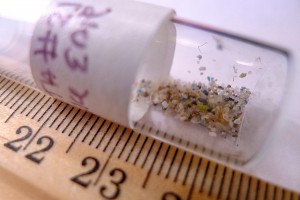
Dear EarthTalk: What on Earth are plastic “microbeads” and how are they threatening the Great Lakes? — Billy Alexander, Macon, GA
Can brushing your teeth or using an exfoliating face or body wash be an act of pollution? Perhaps so, because over 1,000 personal care products contain tiny plastic “microbeads,” each about a half millimeter in diameter. The Los Angeles-based 5 Gyres Institute, which works to end plastic pollution in the world’s oceans, found about 360,000 of these plastic beads in one tube of Neutrogena Deep Clean face wash. Hardly visible to the naked eye, these tiny objects flow straight from bathroom drains into sewer systems.
In July 2012, 5 Gyres went on an expedition with researchers from the State University of New York (SUNY) at Fredonia to determine the micro-plastic pollution of the Great Lakes Region. Data from this study, which was published in the December 2013 edition of the peer-reviewed Marine Pollution Bulletin, revealed an average of 43,000 plastic microparticles per square kilometer in the Great Lakes. The highest concentrations were observed in Lake Erie, and accounted for about 90 percent of the total plastics found.
“We found high concentrations of micro-plastics, more than most ocean samples collected worldwide,” said Marcus Eriksen, the study’s lead author and co-director of the 5 Gyres Institute. “These were of similar size, shape, texture and composition to plastic microbeads found in many consumer products used as exfoliants, giving us circumstantial evidence that these products, designed to be washed down the drain, are not adequately being captured by sewage treatment.”
Sewage treatment facilities are not designed to capture tiny microbeads, and during rainy days sewage can overflow into waterways. Once they enter waterways, they move into fish, which confuse them for food, then into those who eat the fish, including wildlife and humans.
“People simply don’t like washing their face with plastic, and the fact that it’s designed to go straight into the environment makes microbeads a particularly egregious source of plastic pollution,” says Stiv Wilson, Policy Director at 5 Gyres. “These beads are similar in size to fish eggs and can absorb and concentrate toxins found in the aquatic environment, making them an ecosystem wide threat to the food chain.”
Once they determined the scale of plastic microbead pollution in the Great Lakes region, the 5 Gyres Institute launched a campaign asking personal care product manufacturers to remove plastic microbeads from their products. The response has been very positive: Unilever said that it would complete a global phase out of plastic scrub beads from personal care products in 2015; Procter & Gamble said that all of its products will be free of microplastics in 2017; Johnson & Johnson, the maker of Neutrogena facial products, has already begun the phase out of polyethylene microbeads in its personal care products and has stopped developing new products containing plastic microbeads; and L’Oreal has decided not to develop any new products with microplastic-pearls and is also working on a substitute for these exfoliating agents in existing product formulas.
You can determine if there are microbeads in your personal care products by checking the ingredients for polyethylene or polypropylene, or by using the 5 Gyres Institute app, Beat the Microbead, which scans the barcode of products and informs you whether or not they contain plastic microbeads and if the manufacturer has agreed to remove them.
CONTACTS: 5 Gyres Institute, www.5gyres.org
EarthTalk® is produced by Doug Moss and Roddy Scheer and is a registered trademark of Earth Action Network Inc. View past columns at: www.earthtalk.org. Or e-mail us your question: earthtalk@emagazine.com.




